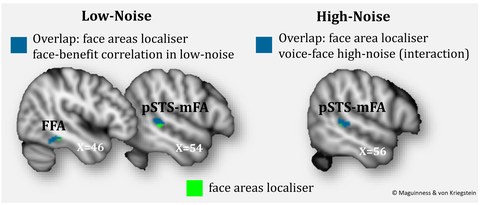Sep 10, 2021
New Paper: Visual mechanisms for voice-identity recognition flexibly adjust to auditory noise level
Recognising the voices of others is something we do every day, often in challenging listening conditions, for example, when we answer the phone on a noisy street. Here, we show that in noisy conditions the visual face processing network responds in a remarkably adaptive manner to support auditory voice-identity processing, even when no face input is available. In low background noise, the fusiform face area (FFA) is engaged. With increasing noise level there is a switch in visual mechanisms - the right posterior superior temporal sulcus motion-sensitive face area (pSTS-mFA) is recruited, and interacts with, voice-sensitive regions in the temporal lobe. The existence of this adaptable audio-visual network helps explain how the brain maintains robust perception in challenging conditions.
Maguinness, C. & von Kriegstein, K. (2021). Visual mechanisms for voice-identity recognition flexibly adjust to auditory noise level. Human Brain Mapping, 42(12), 3963-3982. https://doi.org/10.1002/hbm.25532

